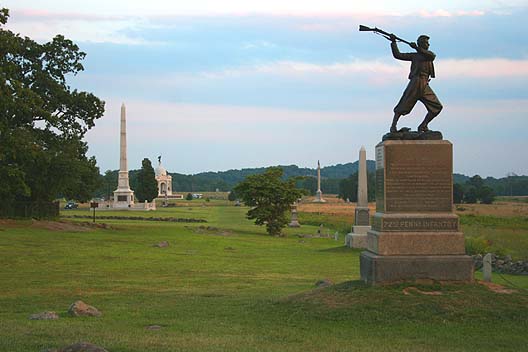Historic Preservation: Fate of the Civil War Battlefields

Here's a look at the ongoing fight to preserve American Civil War Battlefields
by Jennie Wood
 Cemetery Ridge, Gettysburg Battlefield Related Links |
In 1999, the Civil War Preservation Trust (CWPT) was established with the main goal of preserving American Civil War battlefields. In fact, the charitable organization's motto is "Saving America's Civil War Battlefields." CWPT was created when two Civil War battlefield preservation non-profit organizations, the Association for the Preservation of Civil War Sites and the Civil War Trust, merged. Over the years, the Civil War Preservation Trust has grown to 55,000 members and has saved over 32,000 acres of American Civil War battlefields. On January 11, 2011, the CWPT shortened its name to back to the Civil War Trust.
The Civil War Trust acquires land by donation or at fair market value from private parties. Once acquired, the Civil War Trust must take care of the land, usually with help of other preservation groups. If the landowner doesn't want to sell the land, a conservation easement can be arranged with the Civil War Trust. The conservation easement prevents any commercial development on the property in the future. The U.S. Government supports the preservation of Civil War battlefields through the Civil War Battlefield Protection Program, which is run by the American Battlefield Protection Program, a branch of the National Park Service.
The Battle for Fredericksburg
The preservation of Civil War battlefields has proven to be a costly and difficult endeavor. Preserving the Fredericksburg Battlefield has become the most expensive battlefield preservation effort in U.S. history. The preservation effort centered around the 208-acre Slaughter Pen Farm, the one place on the battlefield where visitors can walk through the Union's attack on December 13, 1862, from beginning to end. In 2006, the Civil War Trust purchased the property for $12 million dollars. To help with the Slaughter Pen Farm's preservation, the U.S. Department of Interior awarded the effort with a $2 million grant.
Despite the rapidly increasing development in the suburbs of Richmond, Va., the Civil War Trust has managed to preserve 578 acres (or 75 percent) of the Glendale battlefield. The Civil War Trust also successfully saved the 49-acre Wilderness Battlefield in Orange County, Va., working with local residents and concerned historians to oppose Walmart's plans for a Walmart Supercenter on the land. The opposition inspired a national outcry from preservationists. In January 2011, Walmart announced that it would not build on the historic site.
The Chancellorsville Battlefield preservation effort was threatened in 2002 when a regional developer planned to build 2,300 houses on the 790-acre Mullins Farm, the site of the battle's first day of fighting. The Civil War Trust formed the Coalition to Save Chancellorsville to campaign against the development. The fight over the battlefield went on for almost a year with the Coalition holding meetings and candlelight vigils. Local polls showed that two-thirds of the residents were against the development. Finally, in March of 2003, the Spotsylvania County Board of Supervisors denied the rezoning that was needed for the development. By 2006, the Civil War Trust had acquired over 200 acres of the battlefield.
The Battle for Gettysburg
Even though Gettysburg is arguably the best known of all the American Civil War battlefields, it has faced threats against its preservation as well. Part of the issue is that many significant locations of that battle are beyond the boundaries of the Gettysburg National Military Park. Therefore, they are open to possible commercial and residential development. For example, in July 2009, a Comfort Inn opened on Cemetery Hill, a location of major fighting during the Battle of Gettysburg.
However, in recent years, preservationists have had some victories in the battle over Gettysburg. In 2006 and 2011, two separate proposals to open a casino extremely close to the Gettysburg battlefield were defeated. Also in 2011, the Civil War Trust purchased 95 acres of the battlefield from the Gettysburg Country Club. Still, less than half of the 11,500 acres of the Gettysburg Battlefield have been preserved.
The Civil War Trust, with the help of the U.S. Government, has preserved battlefield land in twenty states. The grassroots and community efforts to preserve these historic landmarks also continue. However, the threat of commercial and residential development on, near and around them continues as well.
- More on Gettysburg

